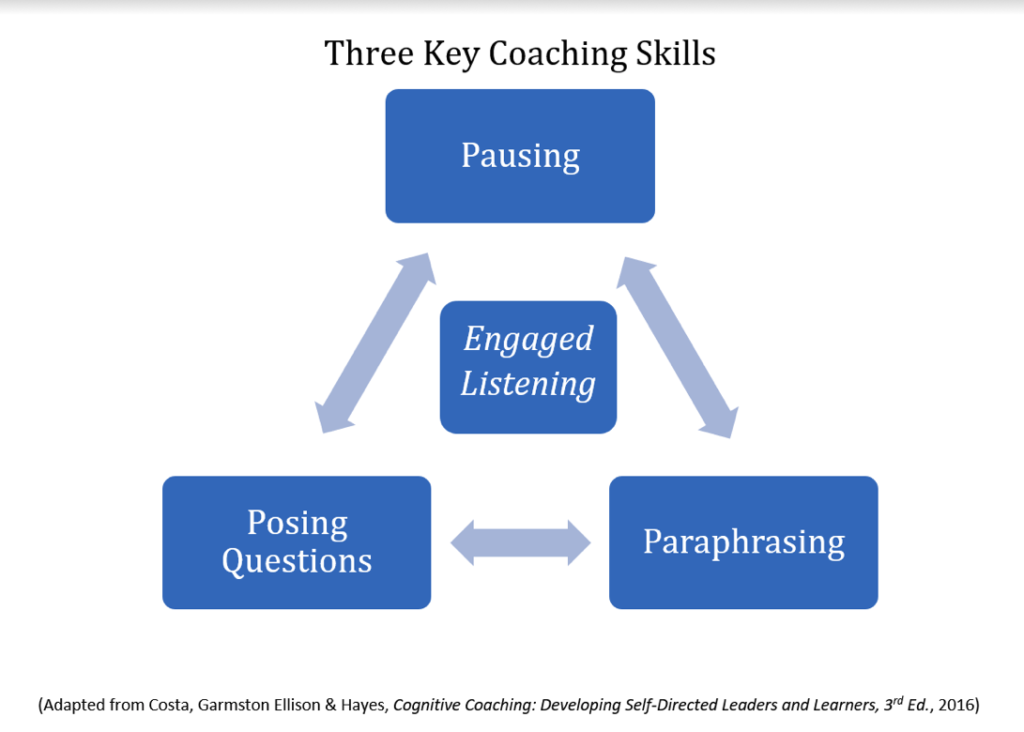A teacher asked me if she should have her students journal digitally or in print. “Which do you think is best?” she asked. We were meeting for our fall individual conference, the first of three for the year.
I was surprised to hear this question after she shared her primary goal of fostering relationships with and among her students.
It also felt like an open invitation to consult. Being perceived as someone with credibility and authority is an ego booster. Who doesn’t like feeling like an expert? It is also worth noting that this teacher is a veteran educator, with decades of experience.
It is also a tricky situation. We as the coach/leader can come into the situation with too much enthusiasm and not enough understanding for what a teacher really needs. We might also deprive them, the client, of the opportunity to solve the challenge themselves.
Developing Trust by Seeking to Understand
This is where I trust my coaching tools. These are key coaching skills and strategies that I lean on when I am entering uncharted waters—complex situations that have no right response other than to be an engaged listener. Particularly, I use
- paraphrasing (restating what the other person said),
- pausing (committing to silence to allow for processing and deeper thinking), and
- posing questions (to clarify confusion or to mediate our thinking).

(For more information on these coaching skills and more resources, check out the website Thinking Collaborative.)
Next is a script of how this initial conversation went, including the coaching tools I used plus my rationale or thinking for each response.
|
Speaker |
What was said/done |
Rationale for response |
| Me | “You are looking for the best environment for your students to write and reflect.” | I paraphrased here to show the teacher I was listening and to confirm her thinking. |
| Teacher | (nodded) | I paused here for four seconds to ensure time for the teacher to process my paraphrase. |
| Me | “I am wondering: What are the pros and the cons of each option—digital versus print journaling?” (I held up both hands to visually organize the two choices.) | I posed a question with the intent of structuring the thinking. It was framed within a positive lens, to convey that there were no wrong approaches here and, ideally, to decrease stress. |
| Teacher | “With journaling on paper, the students will probably write more. They just seem to enjoy print over typing. But I cannot assess their journal entries. With digital, it is the opposite: I can see how they are doing with journaling, but I am concerned they won’t write as much.” | Based on this evidence, it seemed the question fostered deeper thinking around the instructional options. |
| Me | (paused) | There was a lot of information here, so I paused to allow the teacher to process what she had just shared and for me to consider my next response. |
Developing Trust Through Idea Sharing
As coaches and leaders, we are not without our own ideas. We can take positions on these types of issues. Before putting ideas on the table, I find it effective to first ask permission as well as to preface it by saying that this is only my take on the issue and not the only option.
At this point in the conversation about journaling with the teacher, I sensed that we needed that additional option to consider. Here is how the conversation unfolded.
|
Speaker |
What was said/done |
Rationale for response |
| Me | “You want your students to write a lot, and you also want to be able to hold them accountable for writing.” | I organized the teachers’ thinking—two goals—through a paraphrase. |
| Teacher | (nodded) | The teacher confirmed nonverbally, supported with a pause. |
| Me | “Would you be okay with me sharing one possibility with you?” | I asked permission to share an idea, and positioned the idea as “one possibility” to ensure that the teacher still felt empowered. |
| Teacher | “Sure, that’s fine.” |
Next I offered…
What I know about journaling is that it is an opportunity for authentic and reflective writing practice, and that it usually happens privately. It can be helpful when private because our inhibitions go down. We know we are not going to be judged, and subsequently we feel safe to write whatever is on our mind.
Knowing this, is there a way to allow students to journal on their own, while expecting them to take something they wrote in print and expand on it in a digital format, such as a Google Doc or on Kidblog? Maybe once a week? That way you can assess their writing, and they have control in their writing lives.
She paused herself, her eyebrows raised. “Oh, I didn’t consider that.” Here, I noticed she did not jump at the idea. She crossed her arms, and her shoulders closed in a bit. From her body language I suspected she was not ready to accept this idea wholeheartedly. We ended our time together on a positive note but without resolution about the issue.
Developing Trust Through Shared Responsibility
Was I too quick to offer an idea? Maybe. Still, she had asked the question. I clarified what she was asking, and I did ask permission to offer an idea.
Before our winter conference, I read through my observational notes from my frequent informal visits to her classroom. This information, along with her initial goal of developing relationships, guided me to scale back my question as I checked back in on our previous conversation.
“So what did you decide about journaling?”
She must have anticipated this was coming, because she responded right away. “I decided to focus on journaling online and to keep it simple. I do provide some scaffolding, such as questions and choices of topics to write about, plus some relevant issues.”
I affirmed her response. “Kids definitely have more to write about and to say when they have knowledge about the topic.” We both agreed that this opportunity to share through writing, wherever it took place, gave the teacher and peers more insight into their lives.
Trust the Process
Providing someone with feedback is not a simple transfer of information. Are they ready to accept it? If they have requested feedback, are they really ready to consider it?
All we can do is trust the process, both the coaching tools we employ and the professionals with whom we engage. I sometimes fall into thinking that a cycle of inquiry or conversation must end in a clear resolution. But I need to play the long game. Keep showing up, develop the relationships, and have faith that improvement will happen. We can find out if teachers are ready to take risks only by taking similar risks ourselves.


